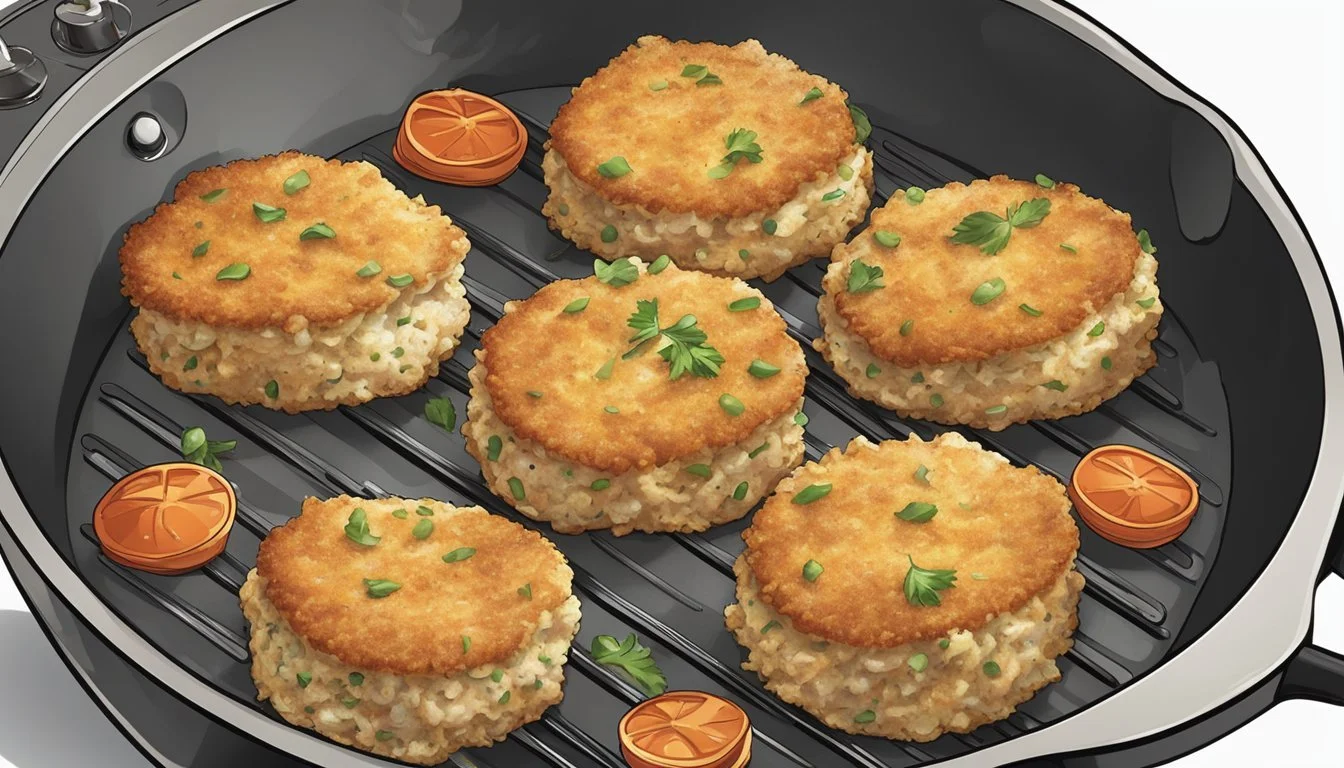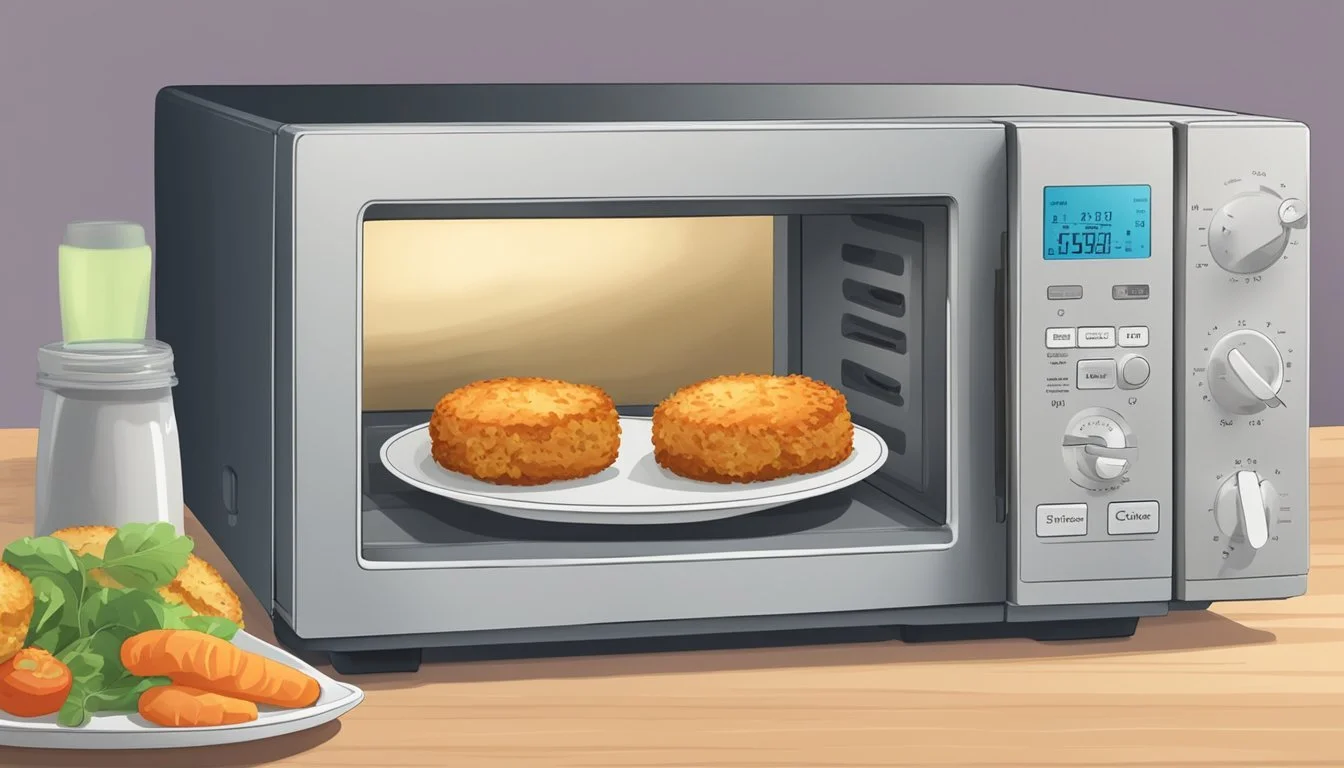How to Reheat Gluten-Free Crab Cakes
Expert Tips for Perfect Warmth
Reheating gluten-free crab cakes can be a simple and satisfying process when done correctly. The best way to reheat gluten-free crab cakes is in the oven at 325°F for 10-15 minutes. This method helps maintain their crispy texture and delicious flavor. Whether they were originally baked or fried, this approach ensures they come out just right.
For those who prefer the stovetop, using a little oil in a nonstick or cast iron pan over medium heat can also work well. Allow the pan to get hot, but not smoking, before adding the crab cakes. Pan frying for 3 to 5 minutes per side will yield a lovely, crispy exterior while keeping the inside moist and flavorful.
Microwaving is another option, though it's the least recommended due to the risk of the crab cakes becoming soggy. If you must use the microwave, reheating them for just a minute or two on medium power with a damp paper towel can help maintain some moisture without sacrificing too much of the texture.
Understanding Gluten-Free Crab Cakes
When making gluten-free crab cakes, selecting appropriate ingredients and ensuring they meet dietary needs is crucial. The focus here is on the essentials of gluten-free ingredients, choosing the best crab meat, and understanding the health and dietary benefits of gluten-free options.
The Basics of Gluten-Free Ingredients
Gluten-free cooking requires careful selection of ingredients to avoid gluten contamination. Essential substitutes include gluten-free breadcrumbs, almond flour, and other gluten-free flours. These alternatives provide similar textures and flavors without the gluten, which is crucial for people with gluten intolerance or celiac disease.
Using gluten-free breadcrumbs gives the crab cakes the needed structure and crunch. Almond flour can add a nutty taste and is a popular choice for many gluten-free recipes. Labels should always be checked for cross-contamination warnings to ensure the safety of those with gluten sensitivities.
Selecting the Right Crab Meat
The type of crab meat can significantly impact the flavor and texture of the crab cakes. Lump crab meat and jumbo lump crab meat are preferred choices due to their large, juicy pieces and minimal shell fragments. Jumbo lump crab meat is more luxurious and has a rich flavor, making the crab cakes succulent and flavorful.
Quality is essential, so look for fresh or well-packaged crab meat. Fresh crab meat is preferable, but canned options can be used if fresh is not available. Opting for sustainable sources can also be a consideration to ensure environmentally friendly choices.
Health Benefits and Dietary Considerations
Gluten-free crab cakes offer several health benefits, particularly for those with gluten intolerance or celiac disease. Removing gluten from the diet can reduce inflammation, improve digestion, and prevent autoimmune reactions in sensitive individuals.
Additionally, crab meat itself is a nutrient-rich ingredient. It's low in fat and high in proteins, omega-3 fatty acids, and essential vitamins like B12. Making them dairy-free by using alternatives for mayo and butter can further cater to specific dietary needs, ensuring a broader range of people can enjoy them.
Ensuring these dietary considerations not only meets health needs but also enhances the overall eating experience by providing delicious and safe options for various dietary preferences.
Preparing the Crab Cakes
Preparing gluten-free crab cakes involves mixing the ingredients and seasoning them appropriately before shaping and chilling the cakes to ensure they hold together well during cooking.
Mixing Ingredients and Seasoning
Begin by gathering simple ingredients such as fresh crab meat, egg, mayonnaise, and Dijon mustard.
Ingredients:
1 pound of crab meat
1 egg, beaten
2 tablespoons of mayonnaise
1 tablespoon of Dijon mustard
1 teaspoon of Worcestershire sauce
1 tablespoon of lemon juice
1 teaspoon of garlic powder
Salt and pepper to taste
In a large bowl, combine the crab meat, egg, mayonnaise, Dijon mustard, and Worcestershire sauce. Add the lemon juice, garlic powder, salt, and pepper. Mix gently to avoid breaking up the crab meat too much. The mixture should be well-blended but still have chunks of crab.
Shaping and Chilling the Crab Cakes
Once the ingredients are mixed, it's time to shape the crab cakes and prepare them for cooking.
Using a scoop or your hands, shape the mixture into patties about 3 inches in diameter and 1 inch thick. Place them on a baking sheet lined with parchment paper.
Chill the crab cakes in the refrigerator for at least 30 minutes. This step helps the cakes firm up and prevents them from falling apart during cooking.
For larger batches, the crab cakes can be chilled for up to a day before cooking, making it easier to prep in advance. Once chilled, the cakes are ready for heating through your preferred method, whether it’s frying, baking, or air frying.
Cooking Methods for Gluten-Free Crab Cakes
Understanding different techniques for cooking gluten-free crab cakes is essential for achieving the perfect texture and flavor. Whether you choose to bake, pan-fry, or use an air fryer, each method offers distinct advantages and can cater to various dietary needs and preferences.
Baking the Crab Cakes
Baking is a healthier method that requires less oil compared to frying. Preheat the oven to 375°F (190°C). Line a baking sheet with parchment paper to prevent sticking.
Arrange the crab cakes on the sheet with some space between them.
Bake for 12-15 minutes, then flip them and bake for another 5-7 minutes.
Broiling for the last 2-3 minutes ensures a crispy exterior.
Pan-Frying on the Stovetop
Pan-frying delivers a deliciously crispy crust. Heat a skillet over medium heat and add 1-2 tablespoons of vegetable oil or butter.
Once the oil is hot and shimmering, place the crab cakes in the skillet.
Cook for 4-5 minutes per side until they are golden brown and crispy. Transfer to a paper towel-lined plate to absorb excess oil.
Using an Air Fryer
The air fryer option is a convenient and less oily method. Preheat the air fryer to 375°F (190°C). Lightly spray the basket with cooking spray to prevent sticking.
Place the crab cakes in the basket without overcrowding.
Air fry for 10 minutes, then flip and cook for another 5-7 minutes until the crab cakes are golden and crispy.
This method uses minimal oil yet achieves a similar texture to frying.
Serving and Presentation
When serving gluten-free crab cakes, consider the choice of accompaniments and the visual appeal of your presentation. Done thoughtfully, these elements can elevate the dining experience.
Accompaniments and Toppings
Pair gluten-free crab cakes with lemon wedges to add a fresh, tangy note. Cocktail sauce, tartar sauce, and hot sauce each offer distinct flavors that complement the rich taste of crab. For a balanced plate, include a side of crunchy coleslaw.
For a wholesome meal, serve the crab cakes as a main dinner course with a fresh salad or roasted vegetables. If serving as an appetizer, smaller portions with Old Bay seasoning can add a traditional touch, enhancing the authenticity and flavor profile.
Garnishing for Visual Appeal
To make the dish visually attractive, garnish with fresh herbs like parsley or dill. Lemon wedges can be artfully arranged around the crab cakes. Drizzle a small amount of sauce over the cakes or serve them in individual dipping bowls for an elegant presentation.
Adding a sprinkle of Old Bay seasoning offers both flavor and a colorful touch. For an Instagram-worthy look, place crisp, colorful vegetables, such as cherry tomatoes or radish slices, around the crab cakes. This not only enhances visual appeal but also makes the dish inviting and mouthwatering.
These thoughtful garnishing choices can transform crab cakes into a family favorite that looks as good as it tastes.
Storage and Reheating
Storing gluten-free crab cakes properly ensures their longevity, while reheating them correctly preserves their flavor and texture.
Proper Refrigeration and Freezing Techniques
To maximize freshness, store leftover crab cakes in an airtight container. Place the container in the refrigerator if they will be consumed within 2-3 days. For longer storage, freezing is recommended.
Allow the crab cakes to cool completely after baking.
Wrap each crab cake individually in plastic wrap.
Place the wrapped crab cakes in a freezer-safe airtight container or a sealable freezer bag.
Label with the date and freeze for up to 3 months.
When ready to use, thaw the crab cakes in the refrigerator overnight for even and safe defrosting.
Guidelines for Reheating to Preserve Flavor and Texture
Reheating gluten-free crab cakes requires gentle methods to prevent dryness. The oven is preferred for retaining texture.
Oven Reheating Steps:
Preheat the oven to 350°F (180°C).
Place the thawed crab cakes on a baking tray lined with foil.
Cover with foil to avoid direct heat.
Bake for 15-20 minutes, removing the foil for the last 5 minutes for crispiness.
Alternatively, use a frying pan:
Heat a pan with medium heat and add a small amount of oil.
Place the crab cakes in the pan.
Cover with a lid and cook for about 2-3 minutes on each side.
For quick reheating, the microwave can be used:
Arrange the crab cakes in a microwave-safe container.
Brush with butter to maintain moisture.
Microwave on medium for 1 minute.
These methods ensure gluten-free crab cakes remain flavorful and moist after reheating.





